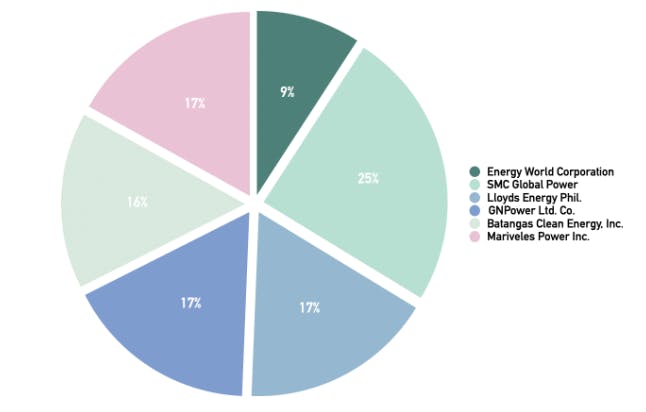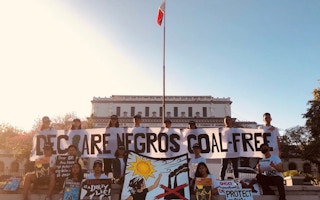San Miguel Corp (SMC), through its energy arm SMC Global Power Holdings Corp, dropped more coal projects from its portfolio, after announcing last month that it was removing the fossil fuel from its expansion plans.
To continue reading, subscribe to Eco‑Business.
There's something for everyone. We offer a range of subscription plans.
- Access our stories and receive our Insights Weekly newsletter with the free EB Member plan.
- Unlock unlimited access to our content and archive with EB Circle.
- Publish your content with EB Premium.
But renewable energy advocates charge that the Philippines’ largest conglomerate may be pivoting to fossil gas, watering-down its intention to boosting its clean energy mix.
In a letter correspondence with Power for People Coalition (P4P), a network of civil society organisations, communities and cooperatives that rally against pollutive fuels, the department of energy (DOE) confirmed on 6 August that SMC will no longer pursue the Central Luzon Premiere Power Corporation and Lumiere Energy Technologies Inc. coal projects in Pagbilao, Quezon, both with a capacity of 355 megawatt (MW) each, and a 82MW plant in Sta. Cruz, Davao del Sur.
“
By jumping to another fossil fuel like gas as it now appears to be doing, SMC reveals itself as nothing more than a sustainability fraud.
Gerry Arances, convenor, Power for People Coalition
However, two weeks earlier, its subsidiary SMC Global Power Holdings Corp said it will convert a proposed 300MW coal plant in San Carlos, Negros Occidental to a liquified natural gas (LNG)-powered facility, as well as build a 1,300MW LNG plant in Batangas City, and put up small-scale gas facilities in Visayas and Mindanao.
Natural gas, which currently accounts for over 21 per cent of the Philippines’s power generation, has been touted as a cleaner-burning fuel because it releases up to 60 per cent less carbon dioxide than coal. But experts have red-flagged methane—a powerful greenhouse gas—that is emitted during its production, transportation and combustion.
“SMC is already parading a renewable energy front, and if it wishes to stick to this, it needs to take the Intergovernmental Panel on Climate Change’s (IPCC) cue and cut off its fossil fuel ties, take responsibility for detrimental impacts of operating projects, and commit to working towards a full renewable energy portfolio,” said Gerry Arances, convenor of P4P.
“By jumping to another fossil fuel like gas as it now appears to be doing, SMC reveals itself as nothing more than a sustainability fraud.”
SMC did not respond to requests for comment.
The IPCC report, authored by the world’s leading climate scientists, was released last week, showing that methane—the largest component of natural gas—must be cut drastically to keep global climate goals within reach.

Capacity share ownership of proposed gas power plants as of 2021: SMC Global Power has the highest share of capacity ownership for LNG at 25%. It is followed by Ayala Corp.’s GNPower Ltd. Co., Dubai-based Lloyds Energy Phil. and Aboitiz Power’s Mariveles Power Inc., each having 1,200MW or 17% share of capacity ownership. Image: CEED
A study released this year by research institution Centre for Energy, Ecology and Development (CEED) revealed that SMC has the biggest ownership share of proposed gas power plants in the Philippines. It is responsible for a fifth of the the total planned capacity through its subsidiary Excellent Energy Resources Inc.’s pending project with a total capacity of 1,740MW.
Sam Reynolds, energy finance analyst of global think-tank Institute for Energy Economics and Financial Analysis (IEEFA) said SMC’s decision to abandon coal plants shows that the “window of opportunity for coal in the Philippines has closed.”
Despite its shift from coal, SMC’s plan to build out LNG infrastructure is “concerning”, said Reynolds.
“The shift to imported LNG could undermine all the economic and climate benefits associated with a clean energy transition. LNG is not clean, cheap, or reliable, and risks locking the Philippines into being dependent on expensive imported fuel for the next 25 years,” he told Eco-Business.
He added: “LNG is also not a transition fuel, since the contracts required for gas investments rely on long-term commitments to purchase and burn the fossil fuel. Rather than continuing to push harmful fossil fuel projects, SMC Global Power has a key opportunity to be a leader in the Philippines’ transition to a clean energy economy.”










